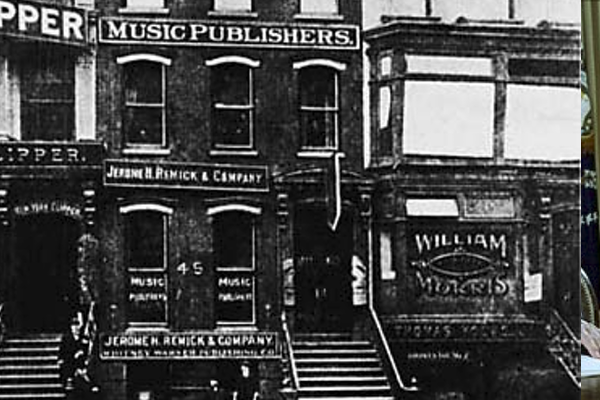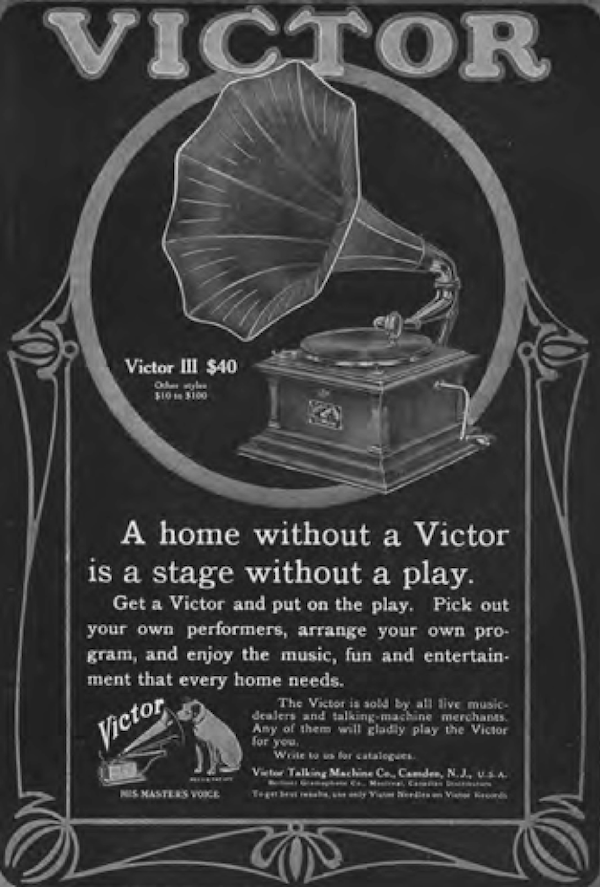Songs for Sale: Tin Pan Alley (Excerpt)

"Tin Pan Alley" Publishing Houses, W. 28th St., Manhattan, 1910
Ragtime’s rise to national, then international, prominence took a full decade. The first decade of the American century would see the creation and rapid rise of the music industry, which, once in place, both made ragtime a phenomenon and broke the spirits of its innovators. Recorded music needed to be marketed and sold, and songs needed to be written in order to be recorded. Lower Manhattan didn’t lack for a “can do” spirit.
In the 1900s dozens of would-be writers saw Charles K. Harris rolling around in “After the Ball” dollars and, hoping lightning would strike Lower Manhattan again, bought themselves a little office space on West 28th Street, between Broadway and Sixth Avenue. It became a warren of songwriters’ offices that was soon nicknamed “Tin Pan Alley” on account of the noise issuing from multiple bashed pianos, not to mention the wastepaper bins – filling up with abandoned songs – that were being kicked in frustration.[i]
Art and commerce were interchangeable on Tin Pan Alley. “Meet Me in St Louis” was written as an advert for the Louisiana Purchase Exposition, otherwise known as the St Louis World’s Fair, in 1904; it would become a hit all over again in 1944 as the theme to one of Judy Garland’s best-loved films. The very soul of cockney London, Florrie Forde’s “Down at the Old Bull and Bush” (1903) was actually American in origin: “Here’s the little German band, just let me hold your hand” was a lyrical clue. It had been written by Harry Von Tilzer, whose real name was Harry Gumm; his mother’s maiden name was Tilzer, and he’d added “Von” for a bit of Tin Pan Alley class. The song was an ad for Budweiser, brewed by Anheuser-Busch – you can imagine the original jingle. Von Tilzer also gave us the boisterous cheeriness of “Wait ’Til the Sun Shines, Nellie,” first recorded in 1905 by minstrel singer Byron G. Harlan, and fifty years later by Buddy Holly.
The era’s biggest American hits, emanating from the Alley – as yet untouched by Missouri’s ragtime – were largely lachrymose stuff. The sentimental “In the Shade of the Old Apple Tree,” written by one Egbert Van Alstyne, was recorded straight by the Peerless Quartet and Henry Burr in 1904, but was so sappy that it was almost immediately parodied, nearly as sappily, by Billy Murray (“I climbed up the old apple tree, ’cos a pie was the real thing to me”). More blubby yet was 1906’s “My Gal Sal,” a last flourish from Paul Dresser, the writer of “On the Banks of the Wabash,” who cried every time he sang one of his own songs.
The portly Dresser, in his cups, was legendarily generous – to his author brother Theodore Dreiser, to the homeless of New York – and gave all of his songwriting royalties away. He died in 1907, aged forty-eight, and so never lived to see himself played on screen by Victor Mature – in the 1942 biopic My Gal Sal – nor to delight in the fact that his on-screen persona would cavort with Rita Hayworth (the film remains one of Hollywood’s most complete rewrites of history – half of the songs in the film were written by Leo Robin rather than Dresser).
The biggest home-grown name, the most celebrated American composer of the decade, wasn’t really American at all. Victor Herbert had been born in Dublin in 1859 and moved to the States in the early 1890s; by 1898 he had his first operetta on Broadway, The Fortune Teller, featuring “Gypsy Jan,” “Romany Life” and “Slumber On, My Little Gypsy Sweetheart” – telltale titles that gave away his Viennese inspiration. New York remained largely immune to the charms of American music. What it needed was some pride, some self-mythologizing, and the person to do that was a smug-looking man in a straw boater called George M. Cohan.
Cohan became the first undisputed king of Broadway with a batch of songs he wrote in his mid-twenties, between 1904 and 1906, and a two-pronged attack that stood his work apart from Herbert’s light operas and home-grown ballads like the Haydn Quartet’s 1905 recording “In the Shade of the Old Apple Tree.” First, he was heavily patriotic – he was all about the New World. Secondly, he mythologized Broadway as a place of glamour (“Give My Regards to Broadway”). No hokum about apple trees; it was all city slicker sentiments and love for the new century. Cohan had been born on July 4, 1878, which entitled him to a certain amount of loud-mouth chauvinism; in 1904 he wrote the most patriotic pop song of the lot, “Yankee Doodle Dandy.” He reacted to critical reviews of his work with a sharp “So long as they mention my name.” Along what lines did he write his plays, one critic asked. “Mainly on the New York, New Haven and Hartford line.” He’s recognizably modern and even has a statue in Times Square, so why isn’t Cohan’s name better remembered? Well, he damaged his legacy by singing his own songs, which wasn’t a great idea, given his inability to stay in tune. Still, it makes for an entertaining listen today: 1911’s “Life’s a Very Funny Proposition” suggests the odd rising and falling cadence of Bob Dylan, only sung in a half-Scottish, half-French accent.

As American songwriters like George M. Cohan began to create American theatre music free of any debt to Vienna or Gilbert and Sullivan, and Will Marion Harris introduced ragtime rhythms to Broadway with his 1903 show In Dahomey, so the gramophone was reinvented for the burgeoning American age in the shape of the Victrola. Thomas Edison himself had thought that any use of the gramophone beyond dictation was in the realms of novelty, and he had a point: it recorded the human voice much better than it did the violin; for any other use it was a squeaky mechanical toy. Talking Machine World was under no illusions and wrote that “the high-brow element professed to find nothing of merit in the talking machine." The piano, on the other hand, continued to be a source of spiritual succour beyond the Victorian age. It took the business savvy of Eldridge Johnson of the Victor Talking Machine Company to make the gramophone an equally acceptable and desirable piece of household furniture in the Edwardian age.
Johnson invented several things which any record collector or twenty-first-century vinyl obsessive would be familiar with today: a straight tone arm, a recess in the middle of the disc on which you could place a paper label, and a box under the turntable in which all of the mechanical parts were neatly contained. This was his new record player, and in 1906 it went on the market as the Victrola. It came in a four-foot-tall mahogany cabinet; Edison’s machines looked like industrial lathes by comparison. Soon, President Taft had a Victrola in the White House, and Johnson milked this news for all it was worth, using photos of Taft in his sales literature.
[i] The first music publisher to move to the block was the successful M. Witmark and Sons – Isidore, Julius and Jay – who moved uptown from 14th Street to 49–51 West 28th Street in 1893. Others soon moved into close proximity: Paul Dresser and Harry von Tilzer from Indiana; and Charles K. Harris from Milwaukee, who had written the schmaltzy but wildly successful “After the Ball” in 1893. By 1900 West 28th Street had the largest concentration of popular- music publishers in the US. A chance hit and a couple of hundred dollars could secure you an office. Tin Pan Alley quickly became so effective at the publication and distribution of sheet music that publishers in other American cities were marginalised.
Excerpted from Chapter 3 of Let's Do It: The Birth of Pop Music: A History, with permission of Pegasus Books.